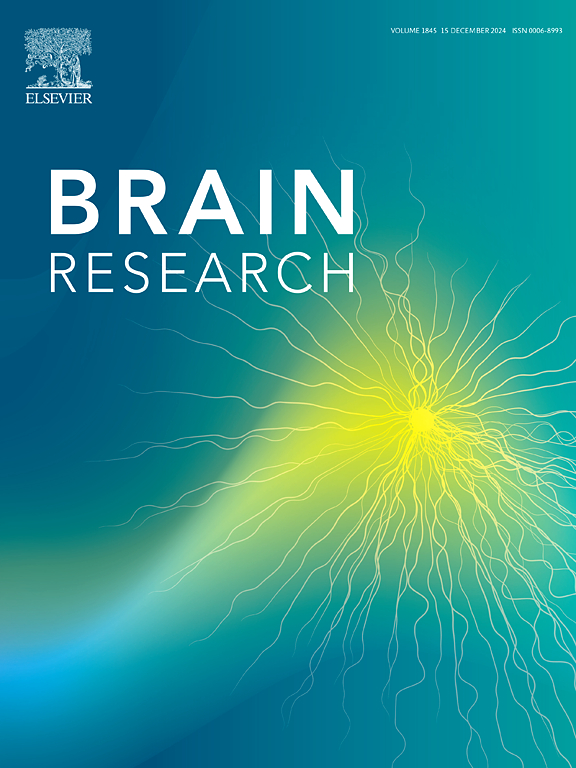循环雌性大鼠后嗅侧内侧杏仁核性别相关基因表达及催乳素对前凸行为的调节。
IF 2.7
4区 医学
Q3 NEUROSCIENCES
引用次数: 0
摘要
大鼠后嗅内侧杏仁核(MePD)是两性二态体,具有高浓度的性腺激素和催乳素(PRL)受体,调节生殖。为了揭示这一社会行为网络相关节点的遗传和功能数据,我们利用RT-qPCR技术研究了ERα、ERβ、GPER1、Kiss1、Kiss1R、PRGR、PRL、PRLR、EGR1、JAK2、STAT5A和STAT5B在雄性和雌性med中沿发情周期的表达。我们还通过在黑暗周期开始前3 h微注射生理盐水、PRL受体拮抗剂Del1-9-G129R-hPRL(1 µM和10 µM)或PRL(1 µM)和Del1-9-G129R-hPRL(10 µM),研究了med中PRL是否会影响发情前雌性的性行为表现。记录雌激素依赖性前凸行为,并比较各组显微注射前(对照组)和注射后(试验)雌性的性接受性。右、左MePD基因表达存在性别差异。ERα和Kiss1R以及PRL、Short PRLR和STAT5B在骑车女性中的表达高于男性。Kiss1在雄性中的表达高于雌性,GPER1在发情期的表达高于发情前期。此外,med中的Del1-9-G129R-hPRL显著降低了发情期雌性前凸的充分显示和商数,PRL的联合显微注射恢复了这一效果。同时,所研究基因的表达表现出特定的性别和发情周期特征,在发情前期,PRL在med中的作用在排卵期前凸的表现中起着重要作用。本文章由计算机程序翻译,如有差异,请以英文原文为准。

Sex-related gene expression in the posterodorsal medial amygdala of cycling female rats along with prolactin modulation of lordosis behavior
The rat posterodorsal medial amygdala (MePD) is sexually dimorphic, has a high concentration of receptors for gonadal hormones and prolactin (PRL), and modulates reproduction. To unravel genetic and functional data for this relevant node of the social behavior network, we studied the expression of ERα, ERβ, GPER1, Kiss1, Kiss1R, PRGR, PRL, PRLR, EGR1, JAK2, STAT5A, and STAT5B in the MePD of males and females along the estrous cycle using the RT-qPCR technique. We also investigated whether PRL in the MePD would affect the sexual behavior display of proestrus females by microinjecting saline, the PRL receptor antagonist Del1-9-G129R-hPRL (1 µM and 10 µM), or PRL (1 nM) and Del1-9-G129R-hPRL (10 µM) 3 h before the onset of the dark-cycle period. The estrogen-dependent lordosis behavior, indicative of sexual receptivity of proestrus females, was recorded and compared before (control) and after (test) microinjections in these groups. Sex differences were found in the right and left MePD gene expression. ERα and Kiss1R, as well as PRL, Short PRLR, and STAT5B expression is higher in cycling females than males. Kiss1 expression is higher in males than females, and GPER1 is higher during diestrus than proestrus. Furthermore, Del1-9-G129R-hPRL in the MePD significantly reduced the full display and quotient of lordosis in proestrus females, an effect restored by the co-microinjection of PRL. In conjunction, the expression of studied genes showed specific sex and estrous cycle phase features, and PRL action in the MePD plays an essential role in the display of lordosis during the ovulatory period.
求助全文
通过发布文献求助,成功后即可免费获取论文全文。
去求助
来源期刊

Brain Research
医学-神经科学
CiteScore
5.90
自引率
3.40%
发文量
268
审稿时长
47 days
期刊介绍:
An international multidisciplinary journal devoted to fundamental research in the brain sciences.
Brain Research publishes papers reporting interdisciplinary investigations of nervous system structure and function that are of general interest to the international community of neuroscientists. As is evident from the journals name, its scope is broad, ranging from cellular and molecular studies through systems neuroscience, cognition and disease. Invited reviews are also published; suggestions for and inquiries about potential reviews are welcomed.
With the appearance of the final issue of the 2011 subscription, Vol. 67/1-2 (24 June 2011), Brain Research Reviews has ceased publication as a distinct journal separate from Brain Research. Review articles accepted for Brain Research are now published in that journal.
 求助内容:
求助内容: 应助结果提醒方式:
应助结果提醒方式:


